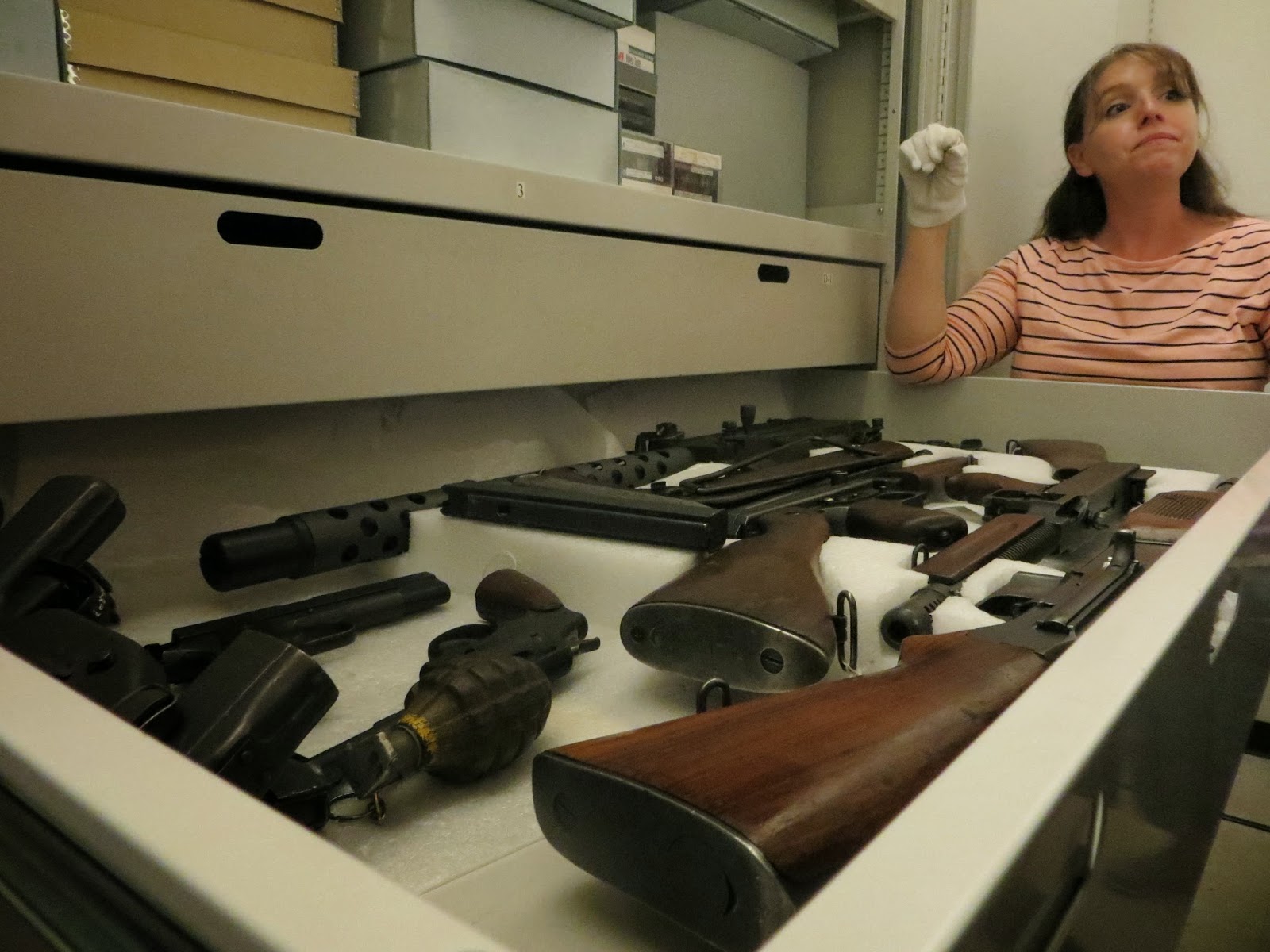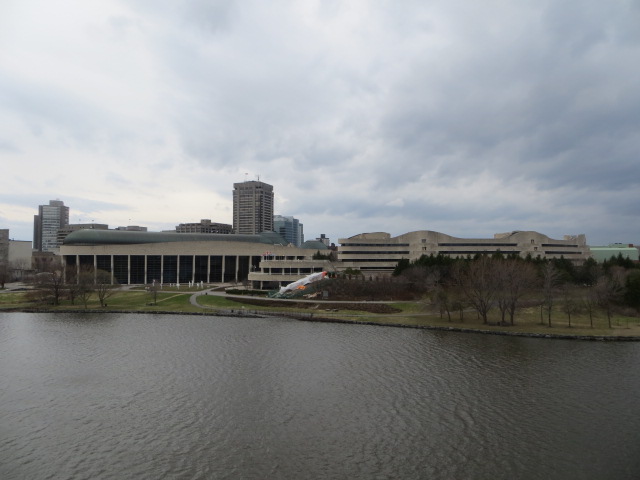As the culminating event in my post-Afghanistan leave, I was able to convince my better half to indulge me on a three day stop in New Orleans, Louisiana as it lay about half way between Disney World and our return to Killeen. The primary reason for this visit is that I have been very anxious to try the new “Behind the Lines” experience currently being offered by the National World War II Museum. However, since my wife is both a public historian and an aspiring World War II buff herself, it didn't take much effort on my part to convince her to go along. One of the highlights of the tour is access to artifacts and parts of the museum not normally available to the general public.
Though the trailer for the tour (yes, there is a trailer) went into great detail about the features of “Behind the Lines” I was still unprepared at just how much access we would be treated to upon our arrival at the museum. Since I’m sure that “Behind the Lines” is something that many of my friends and family would be interested in attending,I've decided to write a detailed breakdown of our itinerary and my reflections.
I would be remiss not to mention that “Behind the Lines” is NOT for the casual tourist looking for a few hours to kill. It is only offered on Fridays and the cost is $395 per person (or $750 a couple) and includes 12 hours of experiences at the museum including what amounts to concierge service from the wonderful travel and conference staff during the visit, personalized guided tours from the volunteer docents, and one and one time with a member of the curator staff. You also receive two meals from the fantastic in-house restaurant, The American Sector, tickets to the two multimedia experiences currently offered at the museum, “Final Mission” and “Beyond All Boundaries,” and finally seating at the evening show offered at the Stage Door Canteen (in this case, “The Andrews Brothers,” a musical review of popular USO music).
In the week prior to our tour, we received an e-mail from Molly Bergeron, Sales Manager, who would be our overall Point of Contact for the visit. She let us know who would be accompanying us on the tour and also a few questions to help personalize our visit. Ahead of time, the museum wants to know what interests you have in the World War II history, what family connections you have with the Second World War, and what connections your home-town had to the conflict so the docents could include more personally relevant information to their presentations.
This led to a discussion between Annie and me as to what this meant for the tour. I admit, rather cynically, I hoped this meant that “Behind the Lines” would be what I like to term as a “Graduate Level” experience. Too often, when I visit World War II themed attractions, I get the standard “The U.S. entered World War II when the Japanese attacked Pearl Harbor on December 7, 1941, etc. etc.” Though this is important, as someone who literally strives to learn something new and fascinating about World War II every single day, 101-level information gets a bit boring and redundant. We did end up covering the basics again, but I am pleased to say, I wasn't at all disappointed.
Also included in Molly’s packet were our complete itinerary, museum information, and instructions to arrive at the main lobby promptly at 9:00 am. As both a Soldier used to “ten minutes prior to ten minutes prior” and someone who was excited as a six year old on Christmas morning, Annie and I arrived around 8:30. Though the main museum was not open, the soda fountain/coffee shop adjacent was and we were able to have a light breakfast while we waited for the other members of our tour to arrive.
Right at 9:00, Annie and I met the other eight members of tour group and Molly Bergeron. I can’t say enough nice things about Molly as we learned she would be with us the entire day and had the somewhat daunting task of ensuring that Eric Muirhead, World War II junkie, and the rest didn't dawdle and miss our time requirements.She distributed special name tags that marked us as “Behind the Lines” participants and introduced us to one of the best tour guides I've ever met, Volunteer Docent Ronnie Abboud. Ronnie began introductions by offering every single lady a hug and every man a hearty handshake. He explained he was born in 1938 and therefore was a little old-fashioned. We didn't mind at all.
Behind the Lines” began with the museum’s new “Train Car Experience” a multimedia kiosk modeled after a Pullman car of the early 1940s. Each seat was equipped with a television monitor that showcased pictures and oral histories of various WWII vets telling what it was like to leave home and ship to basic training. It was a rather unique way of opening things as it gave a brief overview of what it was like for people from different social backgrounds, genders, and services to begin their journey through the Second World War. It also brought up some rather fond (and not so fond) memories of my own experiences with recruiters, MEPS, and the trip to Fort Benning, Georgia that began my own military career.
After the “Train Car Experience” we went to the Second Floor to begin Ronnie’s tour through the European gallery. He did an outstanding job of relating the experiences of the Greatest Generation to the tour participants and most importantly made the history relevant. When he found out that I was active duty Army myself, he let me interject a few anecdotes that really connected my modern experience to what a new recruit in 1942 went through that really made the tour much more enjoyable to me and (I hope) more enjoyable to my tour mates. A particularly moving moment for me was when he recounted the story of a Sherman tank crew’s experience in the hedgerows of Normandy encountering German Tiger Tank at close range. Another fantastic moment that Ronnie brought to life was at a rather banal display showcasing the weapons and equipment of a typical World War II American “Joe” and a German “Landser” that I've seen at a dozen other places. Not expecting anything more than a quick overview of equipment, I began snapping pictures of the equipment as I’m currently working on setting up my own reproduction equipment correctly. Suddenly, Ronnie did something that caused me to pause and reflect. He asked us to realize that the two mannequins beneath the uniforms were the same. It wasn't the differences that were important. It was that they were just two 18 year old kids on opposite sides of history. He highlighted this by asking everyone to look at the Wehrmacht belt buckle on the German Soldier that read “Gott Mit Uns,” revealing the Germans felt like they were fighting on the right side as well.
I could go on and on about Ronnie’s fantastic tour, but at 10:45, Molly appeared again and handed us over to Gaston Andre, a Marine Corps veteran, and member of the museum staff helping to restore an original PT Boat, PT 305. The craft was built in New Orleans and is currently being rebuilt at the museum’s normally off-limits Kushner Restoration Pavilion. Gaston took us around the ship and through the workshops striving to bring PT 305 back to sea-worthy shape. Annie was very interested in both the process of the restoration and the interpretive plan as it was a major artifact being brought back to life. Thought the museum hasn’t quite decided what the ship’s final disposition will be, Gaston hinted you could be seeing a wooden-hulled, World War II speed demon capable of hitting 50 miles per hour coming to Lake Pontchartrain.
 |
| Me with the Museum's STG-44. Yes, it is fully operational and the smile is real. |
 |
| Curator Toni Kiser showcasing some of the museum's world class artifact collection. |
 |
| The Soviet drawer. |
 |
| Me barely squeezing into the driver's hole of the M4A3 Sherman. |
 |
| Curator Toni Kiser poses with Public History Bison on the M4A3 Sherman. |
After the Tang, Molly escorted us back to the Louisiana Pavilion where we met Volunteer Docent Barry Simon for our guided tour of the Pacific Galleries. Barry did another outstanding job of humanizing the conflict in the Pacific and in a particularly moving moment, choked up during his retelling of the Patten family, eight brothers and a father serving in the Navy during the early years of the war. Chosen by fate to be at both Pearl Harbor and the Battle of the Coral Sea, they all survived the destruction of the USS Nevada and the USS Lexington to finish the war together.
As the day wound down, we finally headed back to the Solomon Victory Theater to view the museum’s crowning experience, “Beyond All Boundaries,” a 4D movie narrated by Oscar Winner Tom Hanks about America’s journey through World War II. Annie and I had seen this on our previous visit to the museum and I can only describe it as, “World War II: The Ride.” It is an incredibly moving, immersive journey through history that emotionally captivates you through oral histories, large screens, and special effects. It’s an absolute must for history novices and enthusiasts alike.
Finally, Molly took us over to theStage Door Canteen for dinner and a show before finally said her goodbyes. After thanking her for all her hard work, we were treated to a wonderful meal where all the members of the tour group were able to discuss our experiences during the day and get treated to a viewing of “The Andrews Brothers,” the museum’s latest musical review. Performers skillfully brought the music and costumes of the '40s back to life in the guise of a USO show that suddenly finds itself without its stars on a South Pacific island.
As Annie and I walked back to our hotel room at the end of the day, both of us were tremendously impressed with the program the National World War II Museum put together. Molly was there every step of the way to make our visit a spectacular memory, Ronnie and Barry, our volunteers both helped bring new life to our tours of the galleries, and Gaston Andre let us see history getting rebuilt to its glory. Toni Kiser was absolutely outstanding and it was a real privilege to have one of the museum’s leaders take us through so many rare and beautiful artifacts. She also indulged Annie and I and let us see how a world class museum organizes its collection and constructs the experience for its visitors.
“Behind the Lines” is exactly that: A real adventure through the inner-workings of the National World War II Museum. To anyone with even a passing fascination with the world-changing events of 1939 to 1945, TAKE THIS TOUR. It is a gift you give to yourself. Plus, your contributions will help ensure that this fantastic museum and its staff will be able to keep telling the story of the Greatest Generation for many years to come.


































